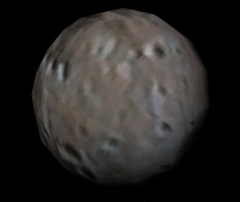3753 Cruithne
|
Project home: Cruinthe Asteroid 3753 |
3753 Cruithne, known in Orbiter simply as Cruinthe is an asteroid, belonging to the w:Aten asteroid group, in an elliptical solar orbit with almost a 1:1 resonance with the Earth, and was discovered on 10 October 1986 by w:Duncan Waldron. It's orbit takes Cruinthe from the orbit of Mercury to beyond that of Mars. In Orbiter, Cruinthe was added as an Add-on by Burnrate in 2009.
Note about the name
It is to be noted that the actual body is named 'Cruithne', whereas the name of the body in the add-on for Orbiter is 'Cruinthe'. In this article, when referring to the actual body, 'Cruithne' will be used; when referring to the body on Orbiter, 'Cruinthe' will be used.
Physical Characteristics in Orbiter
Cruinthe has a diameter of about 3300 meters, and a mass of 4.05×1013 kg. The surface gravity is only about .001 m/s2 and escape velocity is about 1.8 m/s, so, one may be able to jump beyond escape velocity. When landing a spacecraft, it may touch down slightly above or below the surface.
Orbital Characteristics in Orbiter
Cruinthe revolves around the Sun at a semi-major axis of just under 1 AU, almost the same distance as the Earth, with an eccentricity of a bit over 0.5, resulting in an orbit that ranges from just outside that of Mercury out past that of Mars.
Orbiting the Sun in slightly under a year, the actual Cruithne is in lockstep with Earth, approaching within about 12 million km, then drifting to the opposite side of the Sun from the Earth, to about the same distance on the other side of the Earth. It's unknown whether this phenomena is modeled in Orbiter.
Rotational characteristics
Cruinthe rotates upon its axis in 98784 seconds, or 27h 26m 34s.
Notice to pilots
Due to its size and mass, and the distance from the Sun, the Sun's gravity is stronger than that of Cruinthe, OrbitMFD shows Cruinthe gravity at 0.15 and the Sun's at 0.85, so you may touchdown and stay on the surface, albeit barely, but as often you will begin to drift off the surface. Perhaps the best landing is on the night side as Cruinthe and the Sun are pulling in the same direction.
The landing light of the DeltaGlider doesn't seem to work on Cruithne.
See also
- 3753 Cruithne at Wikipedia.

